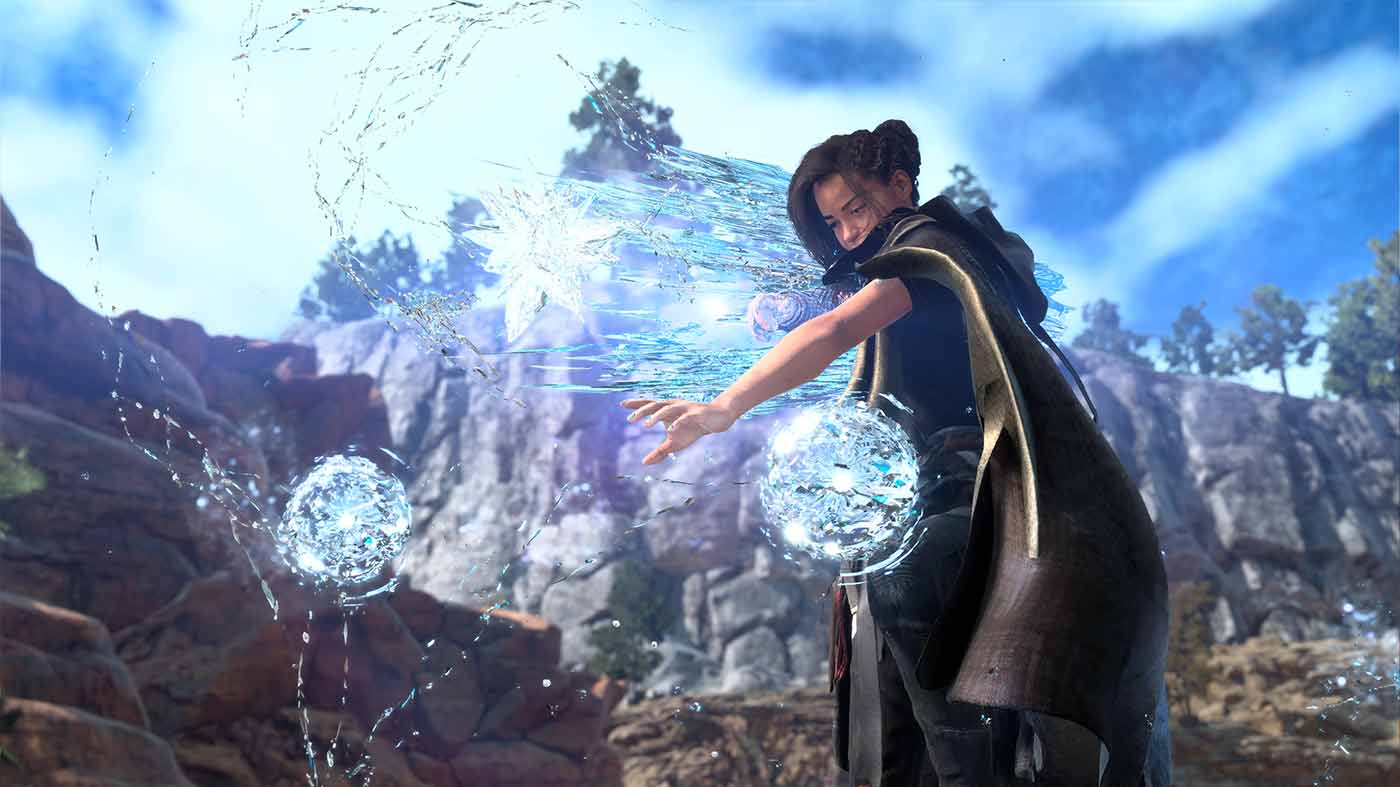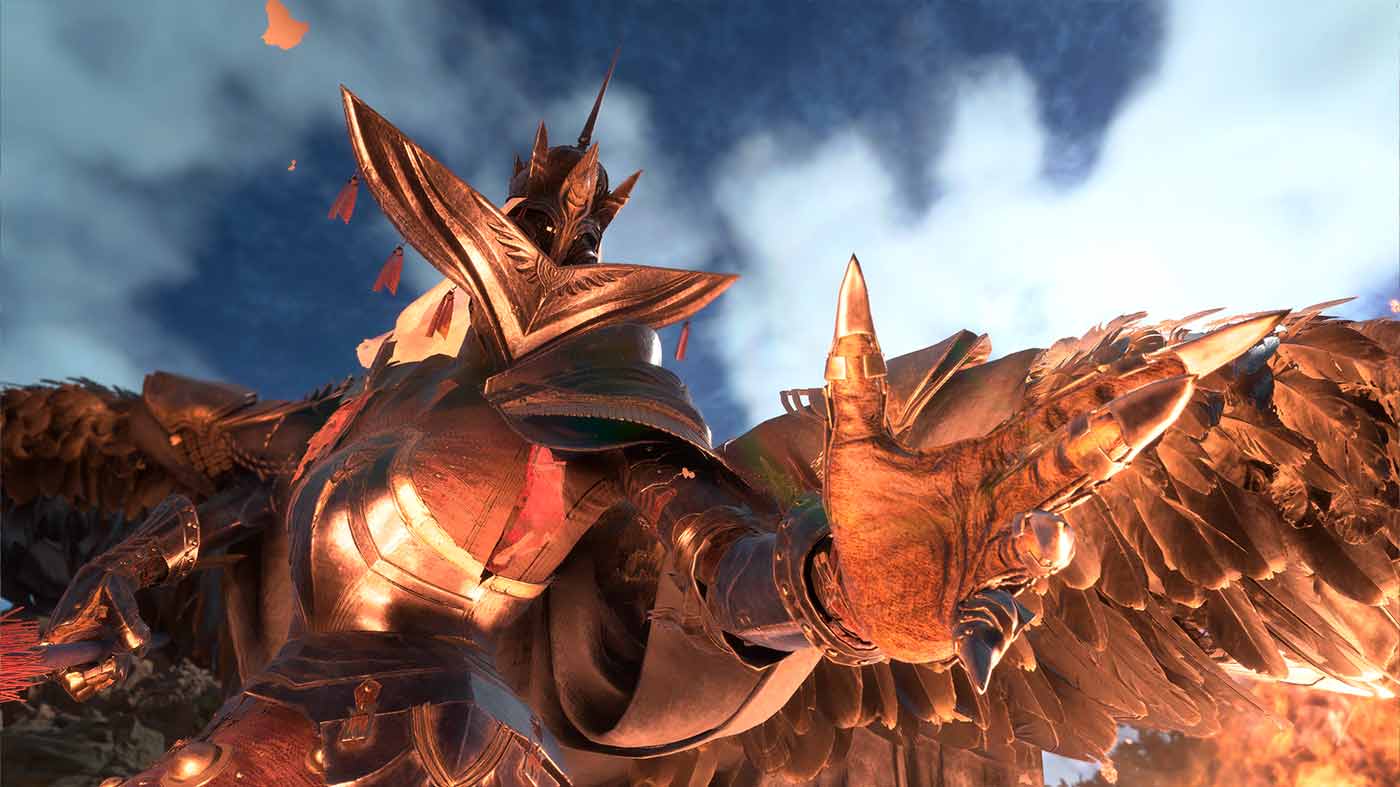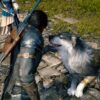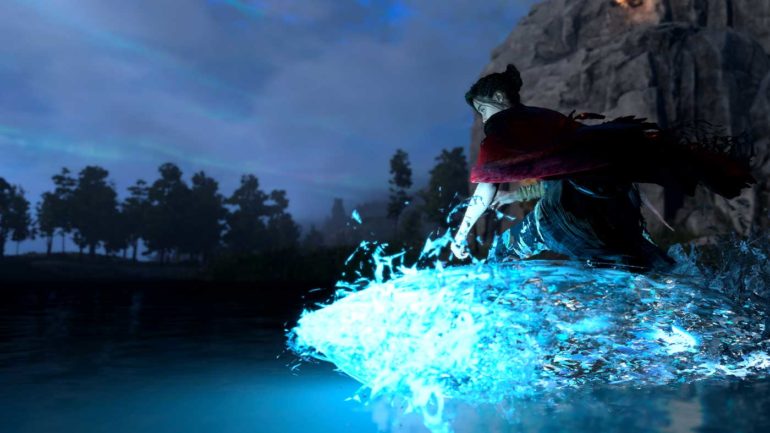I’ve been gushing about Forspoken ever since I recently had the chance to play just over an hour of the game in a special hands-on preview session (well, since I’ve been allowed to talk about it at least!) and for good reason. From what I experienced of the game, it’s shaping up to be an excellent action RPG with compelling magical combat and parkour, even if the quality of its narrative and world are still a bit of an unknown. With some experience under my belt, I was also lucky enough to chat with three of the team at developer Luminous productions about their approach to gameplay in Forspoken as well as how the most recent delay will help the game when it finally launches early next year.
I spoke to Creative Producer, Raio Mitsuno as well as Co-Director, Takeshi Terada and Cinematic Artist, Roosa Jokiaho, who were all super passionate about the game they’ve been working on and delightfully candid in some of their responses. If you haven’t already though, I recommend reading my preview of the game first to add a little context to the conversation below which will hopefully expand upon some of the points I’ve already raised:
Since we’re talking about gameplay and especially combat today – let’s start with the fact there are 100 spells in the game! How did you come to such a huge number and how do you keep that under control?
Takeshi Terada: The idea to have 100 spells available for the player was actually a concept that came from the initial stages of development. And, you know, creating 100 different spells is quite a challenge. But we sort of gathered the whole team together and threw ideas out there saying, “I think this would be good? Do you think it would be good to have this? I reckon this kind of magic would make the battles really fun.” And so then we just kind of chose from those ideas quite freely and with flexibility.
As well we’d have the concepts of how the magic would be used, for example, close range magic, mid range magic and long range magic. And then once we’d settled on those categories, we looked at expanding different magic spells within each of those so we did also keep in mind how they were going to play and how it was going to contribute to the battles as we were coming up with these ideas.

With that many possible spells for Frey to use, how do you keep things easy for players to grasp and manage?
TT: So there are a couple of ways which we work to sort of balance or to alleviate that. One way is that the magic unlocks alongside progression in the story, it’s not like the player will just suddenly be given 100 spells and let loose on those. They may start with, say 10, and then another 10 as they progress through the story, and that will gradually open up. So one of the ways in which we sort of balanced this was through that sort of timed release as you will.
And then a second way in which we tried to alleviate that overwhelming sort of decision making process is that the enemies all have their own weaknesses and resistances to different spells. So, with those two methods, by making sure that the spells unlock in line with progress and giving the enemies their own weaknesses and attributes, I think we’ve managed to alleviate, as you say, some of that pressure of having so many spells at your disposal.
One of my favourite things during the demo session was seeing how Frey’s animations and abilities changed when using different spells in a row or in conjunction with parkour. Is that something that becomes important to succeed in combat?
TT: For clarity if you were to use two magic spells together, they won’t necessarily change into a different magical spell, but we have made a lot of adjustments on our side and been really mindful of the way in which the magical parkour and spells, particularly the close range spells, work together. For example, if an enemy comes in to attack, and you dodge it using magic parkour, and then you follow that up with a close range spell of some kind, the animations and the motions that the character will take are different, they’ll be unique compared to the usual attack.
Raio Mitsuno: We don’t have any specific combos that we designed per se, but there are spells like you might have experienced, there’s a spell called Oblique for example, which can trap enemies in this giant water bubble. And you could use that just to trap them so that you can kind of play keep-away or you could follow that bubble up with an attack and make it explode. So there are ways you could experiment and kind of just test out what might work and what might not work. That’s part of the fun of having 100 spells is that you could try different things and find your own combo.
Magical parkour is a big part of the game, and at one point I got an upgrade that boosted my ability to scale heights. How much will Frey’s traversal skills improve over the course of the game?
TT: So this idea of upgrading or strengthening the magic is something that’s really important in the world of Athia and to the game itself. So you are correct that there will be all of these upgrades. But in terms of sort of specifics of how fast she’s going to be able to go and what exact level it’s going to reach, I think we’d prefer you to experience that for yourself when you actually play the game.
But to add to that a little bit. We’re kind of viewing the strengthening and the upgrade of magic to be an element that’s for a little bit more intense play for people who really want to, you know, strengthen particular spells that they really like and see how far they can push them by using them over and over quite repeatedly and really honing in on that. So it’s perhaps a slightly more committed part of the gameplay.
There were a few difficulty options mentioned in the demo, can you tell me anything about how these work?
TT: So, in general, the difficulty level can be changed according to the player’s choices. We have a few difficulty levels, for example the Story mode, the Open World mode and the Action mode. And obviously the Story mode is for those who just want to focus on the narrative experience, whereas the Action mode is more for those who want that sort of challenging and satisfying battle experience.

I feel like the Luminous Engine has a very distinct look, especially when it comes to massive landscapes and very nice-looking particle effects. Were there any lessons you took from its use in Final Fantasy XV or strengths that you expanded on for this game?
TT: Unlike FFXV, I think the core point that we sort of really took on and learnt from really was that for Forspoken, we’re trying to create a new IP and a brand new experience. So that gave us the opportunity to do things that we perhaps couldn’t explore in XV, and to look at things in a new and different way. And that includes in terms of the graphics and the art as well. So for us, we’ve really kind of explored that in this new way. But having said that, when people do play it give us their feedback, we have heard a lot of comments about how it feels reminiscent of XV in some ways. And that’s actually fairly surprising and quite a fresh look on things. So yeah, that’s really how it is from our point of view.
On the engine side of things, one of the big advantages that we have as a development team is that we have our own engine. So instead of relying on capabilities of third party engines, we can tweak our gloominess engine to, you know, based on our needs. So if you want our game do a certain thing that the engine doesn’t do yet. We could we have programmers that could add that into the engine to make that happen. So that is one of the things that I think I know I don’t have a list of all the improvements and things that we’ve changed from 15. But there’s been many things under the hood that we’ve adapted from that since then, since because the engine basically is developed alongside our game, so to speak. So as long as the engine is is well and alive in our own thing. We could keep that going in terms of you know, making advancements to work for our game.
I noticed there are three visual mode options in the game, at least on PS5, can you tell me what the differences are with each one?
RM: We do have a few graphics modes in the game, kind of the normal set that we see in most current gen games. We have a Graphics mode that will prioritise visuals, so it’ll render up to 4K and that’s at 30 frames per second. We have a Ray Tracing mode that’ll render slightly lower, I think closer to a 3K resolution, which will target 30 frames per second and then a Performance mode which will lower it to around 2K resolution at 60 frames per second. But every mode uses dynamic resolution so it’ll change on the fly and sometimes it’ll be higher than others but yeah, we’re taking advantage of all the capabilities of the current consoles for sure.

The game has been delayed a couple of times now, can you talk about the decision behind the most recent delay into 2023? How are those extra few months going to benefit the final product?
RM: Because we have a new IP, we looked at the market, and we wanted to give our game the best possible chance for success but also the best opportunity for fans to play the game. So we kind of looked at all the aspects of that. We talked internally and we thought, you know what, it’ll benefit everyone across the board if we just delayed by a couple months. And what that resulted in is a couple of extra months that we didn’t think we would have to do extra polish.
TT: From a development perspective, having this extra development time has of course allowed us to go in and polish up graphics and also carry out some optimizations. But it also allowed us to sort of add more content in terms of things like re-recording some voices that weren’t necessarily where we wanted them. And so I think that in general, all aspects of the game have been improved from this extra time.
Roosa Jokiaho: Also, from the art perspective, it’s been really nice to actually have extra time to go and polish very small things. Because typically we only get time to focus on the overall picture. And then there’s all these little details that keep nagging us in the finished game. But this time, we just got a few months bonus so we’re tweaking all the little things that we typically don’t get to fix.
Forspoken launches on January 23, 2023 for PS5 and PC. Amazon has the cheapest PS5 pre-order price at $84.90 with free shipping.



